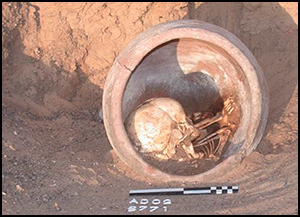Article contents
From refuse to rebirth: repositioning the pot burial in the Egyptian archaeological record
Published online by Cambridge University Press: 21 November 2016
Abstract

The interment of bodies in ceramic vessels, or ‘pot burial’, was a widespread practice across the ancient world. Commonly associated with poverty, and with child and infant burials, the reuse of domestic vessels for burial has been taken to indicate that low value was assigned to the containers and their contents. New analysis urges a more holistic and culturally situated understanding. Contradictory evidence reveals that this burial practice was also used for adults and is represented in high-status tombs. Far from being recycled ‘rubbish’, the ceramic containers may have reflected symbolic associations between pots, wombs and eggs, facilitating rebirth and transition into the afterlife.
Keywords
- Type
- Research
- Information
- Copyright
- Copyright © Antiquity Publications Ltd, 2016
References
- 7
- Cited by


